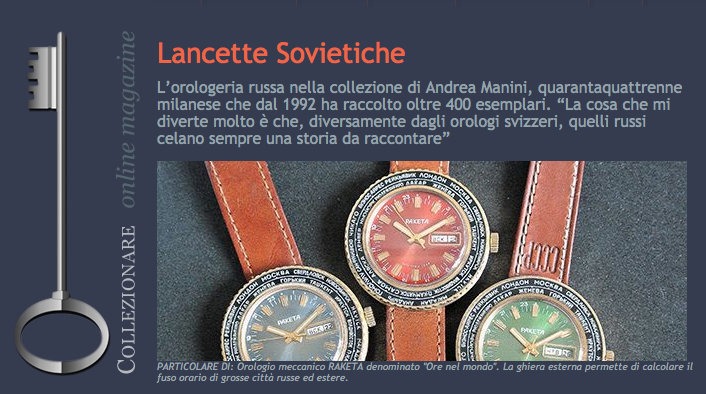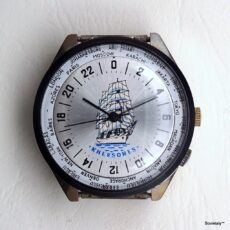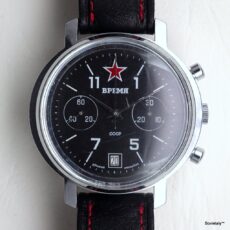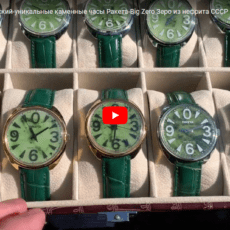It may seem unusual, but sometimes a collection of Soviet/Russian watches can capture the attention and appreciation of even those who are not experts in the field. This intriguing niche of collecting has recently been highlighted in an interview published by the magazine “Collezionare,” available in both print and digital formats (www.collezionare.com).
The Magazine “Collezionare”
The magazine “Collezionare” is a specialized publication focused on the world of collecting, offering in-depth articles, news, and interviews on a wide range of collectible items. From vintage to antiques and modern collectibles, the magazine serves as an authoritative and up-to-date resource for enthusiasts. Available in both print and online versions, “Collezionare” stands out for the quality of its content and the passion with which it tells the stories of collectors and their unique collections.
Two years ago, I contacted several journals related to collecting to promote my father’s Pirelli advertisement collection, including “Collezionare”. The interview with my father can be found at this link. Given the existing contact, a couple of months ago I reached out again to the journalist who conducted the interview, suggesting she might also be interested in my collection of Soviet/Russian watches. A few days later, she contacted me to schedule a phone interview.

On April 14, 2018, the online version of the interview was published and can be read at this link.
Soviet Watches
In the interview, Andrea Manini, a 44-year-old from Milan who has been collecting since 1992, shares insights into his collection of over 400 Russian watches. “What I really enjoy is that, unlike Swiss watches, Russian ones always have a story to tell.”
The Stories Behind Soviet Watches
Many stories surround Soviet watchmaking, particularly those involving Yuri Gagarin, the first man in space. The watch he wore during the 1961 mission is still a mystery. Some claim it was a Poljot Sturmanskie, produced by the First Moscow Watch Factory, often referred to as the Russian equivalent of the Speedmaster used by Armstrong and Aldrin on the moon. Others believe it was the Type One by Sturmanskie, citing a photo where Gagarin wears this model over his red suit. “But who can say for sure? Maybe it was just a training shot,” says Andrea, emphasizing the mystery that often surrounds these famous timepieces.
The Influence of History on Soviet Watchmaking
The end of the Soviet Union in the early 1990s marked the beginning of a new era for Russian watchmaking in Italy. Andrea, like many other enthusiasts, started his collection in 1992, the year after the USSR’s dissolution. “1992 is my year zero, the year I began to appreciate these beautiful watches. That year, the first after the dissolution of the Soviet Union, all the unique goods from the former USSR became very sought after, including Russian watches, which started appearing in our jewelry stores. Over the years, I have expanded my collection to about 400 pieces.”
Early Discoveries
Andrea’s first purchase was a Vostok Komandirskie wristwatch. “The military look and the rocket on the dial attracted me, and only later did I discover that it was a Vostok Komandirskie model, with the Vostok 1 rocket that Gagarin used to orbit the Earth in 1961.”
Collection Categories
Russian watches are categorized in various ways. Andrea focuses on Russian space adventures and Soviet watches made for the Italian market. Other themes include Soviet polar explorations and Russian railways, particularly the BAM line.
The History of Russian Watchmaking
Russian watchmaking has a complex history intertwined with the country’s social, political, and military developments. During the Tsarist era, watches were mainly produced by artisanal workshops. With the advent of the Soviet Union, watch production became essential for both civilians and the military. Initially, pocket watches were produced, but gradually, wristwatches became the focus.
Watch Factories
Numerous companies arose in the Soviet Union, named after war or space adventures. “The First Moscow Watch Factory, later named Poljot (which means flight), Raketa (rocket), Pobeda (victory, dedicated to WWII), and Chaika (seagull, which was Valentina Tereshkova’s code name during her space flight).”
Export and Marketing
In the 1960s and 70s, Soviet watches were exported at low prices to promote sales. This was a state-imposed strategy. In Italy, Russian watchmaking has often been underrated due to its proximity to Switzerland. However, the Russians understood the importance of marketing and created watches with logos for export or specific models for certain markets.
Rare Models
Among the rarest models in Andrea’s collection is a Raketa Big Zero with a nephrite dial, a green stone similar to jade. Finding rare models is challenging, especially online where many fakes and assembled pieces are sold.
Tips for Collectors
To avoid buying fakes, Andrea advises consulting more experienced and reliable collectors. “Today, there are many forums and groups where you can exchange opinions and advice.”
This collection of Soviet/Russian watches, with its rich history and intriguing models, continues to captivate not only enthusiasts but also newcomers to the world of collecting.



